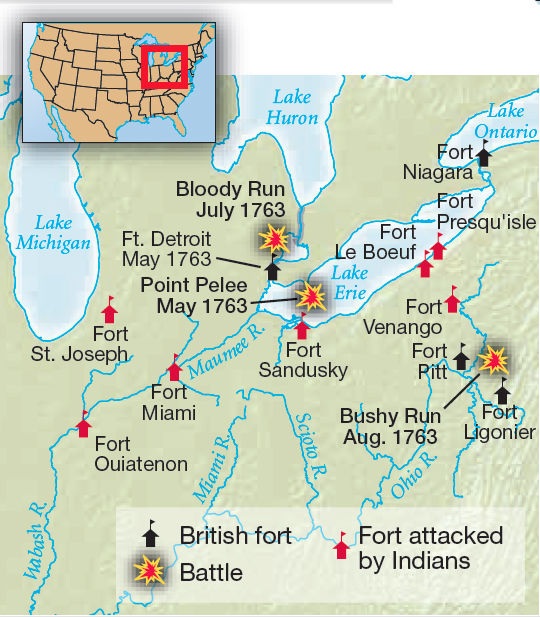Pontiac's Rebellion and the Proclamation of 1763
Printed Page 148
One glaring omission marred the Treaty of Paris: The major powers at the treaty table failed to include or consult the Indians. Minavavana, an Ojibwa chief of the Great Lakes region, put it succinctly to an English trader: “Englishman, although you have conquered the French, you have not yet conquered us! We are not your slaves. These lakes, these woods and mountains were left to us by our ancestors …; and we will part with them to none.”
Indians north of the Ohio River had cause for concern. Old French trading posts all over the Northwest were beefed up by the British into military bases. Fort Duquesne, renamed Fort Pitt to honor the victorious leader, gained new walls sixty feet thick at their base, announcing that this was no fur trading post. Tensions between the British and the Indians in this area ran high.

A religious revival among the Indians magnified feelings of antagonism toward the British. In 1763, the renewal of commitment to Indian ways and the formation of tribal alliances led to open warfare, which the British called Pontiac's Rebellion, named for the chief of the Ottawas. In mid-May, Ottawa, Potawatomi, and Huron warriors attacked Fort Detroit. Six more attacks on forts followed within weeks, and frontier settlements were raided by tribes from western New York, the Ohio Valley, and the Great Lakes region. By fall, Indians had captured every fort west of Detroit. More than four hundred British soldiers were dead and another two thousand colonists killed or taken captive.
 A coordinated uprising of Native American tribes in 1763 in the Northwest after the end of the Seven Years' War. The rebellion heightened Britain's determination to create a boundary between Americans and Indians, embodied in the Proclamation of 1763.
A coordinated uprising of Native American tribes in 1763 in the Northwest after the end of the Seven Years' War. The rebellion heightened Britain's determination to create a boundary between Americans and Indians, embodied in the Proclamation of 1763.
Some Americans exacted revenge. The worst violent aggression occurred in late 1763, when some fifty Pennsylvania vigilantes known as the Paxton Boys descended on a peaceful village of friendly Conestoga Indians, murdering twenty. The vigilantes, now numbering five hundred, marched on Philadelphia to try to capture and murder some Christian Indians held in protective custody there. British troops prevented that, but the Paxton Boys escaped punishment for their murderous attack on the Conestoga village. To minimize violence, the British government issued the Proclamation of 1763, which chiefly aimed to separate Indians and settlers, with added restrictions on trade and land sales.
The Proclamation of 1763
> The Proclamation of 1763
- Colonists were forbidden to settle west of the Appalachian Mountains.
- The Proclamation offered assurances that Indian territory would be respected. It limited trade with Indians to traders licensed by colonial governors, and it forbade private sales of Indian land.
- Western lands were referred to not as the Indians' land, but as lands that “are reserved to [Indians], as their Hunting Grounds.”
- American and French colonists in Canada were British subjects entitled to English rights and privileges.
- Indians were not British subjects and were instead referred to as “Tribes of Indians with whom We are connected.”
The Indian uprising had faded by early 1764, but the 1763 boundary was a further provocation to American settlers and also to land speculators who had already staked claims to huge tracts of western lands in hopes of profitable resale. Yet the boundary proved impossible to enforce. Surging population growth had already sent many hundreds of settlers, many of them squatters, west of the Appalachians. Periodic bloodshed continued and left the settlers fearful, uncertain about their future, and increasingly wary of British claims to be a protective mother country.
QUICK REVIEW
Question
How did the Seven Years' War erode relations between colonists and British authorities?
How did the Seven Years' War lay the groundwork for colonial crisis?
Why did the Sugar Act and the Stamp Act draw fierce opposition from colonists?
Why did British authorities send troops to occupy Boston in the fall of 1768?
Why did Parliament pass the Coercive Acts in 1774?
How did enslaved people in the colonies react to the stirrings of revolution?
Conclusion: What changes did the American colonists want in 1775?
 LearningCurve
LearningCurve
Check what you know.